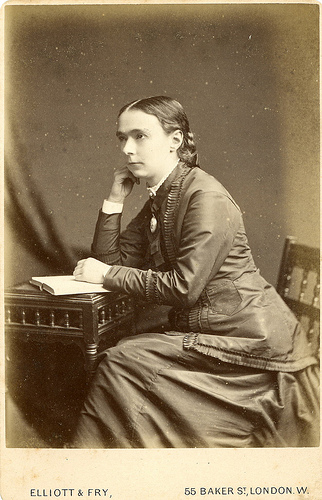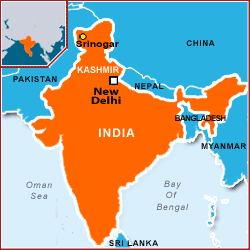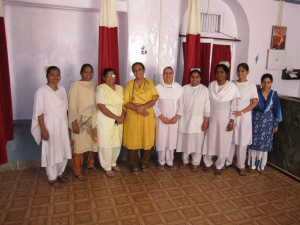These are they which follow the Lamb…..
We have been reviewing the lives of many of the remarkable women of the nineteenth century. Many opportunities opened up for women to minister in the Kingdom of God in the 1800’s. There was a tremendous new interest in religion that came as a result of the Great Awakenings that would lead to the desire to spread the Gospel. A belief that Christ would come when the Gospel was preached to the ends of the earth prompted many to be a part of a great missionary movement within the United States and into foreign countries. Jesus said, “This gospel of the kingdom shall be preached in the whole world as a testimony to all the nations, and then the end will come.” (Matthew 24:14)
There was a particularly great need for women in foreign countries especially in the medical field. Women in India for example were not comfortable with male doctors. Even today in Muslim countries women are not allowed to be treated by a male doctor unless he is a close relative. The need for female medical missionaries continues to be very great.
One woman who answered the call of God in her life to minister to women in India was Fanny Jane Butler. Though she only lived to be 39 years old, Dr. Butler was able to assist in the treatment of thousands of women. She was also instrumental in founding a hospital that is still in existence today.
was Fanny Jane Butler. Though she only lived to be 39 years old, Dr. Butler was able to assist in the treatment of thousands of women. She was also instrumental in founding a hospital that is still in existence today.
Fanny was born on October 5, 1850 to Thomas and Jane Isabella Butler. She was the eighth of ten children. Only her brothers received formal education. Fanny was an intelligent girl and had a thirst for knowledge, but she had to be content with teaching of her older sisters until she was nearly 15 years old.
When Fanny was thirteen she gave her heart to Christ. At fourteen she became a Sunday school teacher. Her attention was directed to missions by her pastor who was very enthusiastic about taking the Gospel to those who had not heard about Christ. Fanny developed a deep missionary spirit. She asked her parents if she could be a missionary but they would not give her their approval at this time.
A little later on Dr. Elmslie, a Scottish medical missionary, was trying to get female medical missionaries to come to India. Fanny’s sister encouraged her to consider this. At first Fanny did not think she could do it. Later she decided to seek God’s will and when she was sure that medical missionary work was for her she again approached her parents. This time they enthusiastically gave their support.
Fanny became a member of the Indian Female Normal Society. She attended the London School of Medicine for Women for her medical training. This was a new school that only recently had accepted women. Fanny passed second out of one hundred and twenty-three candidates applying for the school; one hundred and nineteen of them were men.
She was a top student and received only flattering testimonials from her teachers. She took her final examination in Dublin where her professor said that her paper was the best he had ever had from any candidate. Fanny received the prize of pathology in 1879 and prize of anatomy in 1880.
In 1880 Fanny went to India as the first fully equipped female medical missionary sent from England. Her first destination was Jabalpur in the central part of India. Owing to some complications she traveled to Bhagalpur. She spent four and a half years in Bhagalpur pouring her whole energy into working in the dispensaries and attending several thousand patients a year.
In 1887 Fanny returned home to England for a short furlough. After this she  accepted an appointment in Kashmir specifically in order to work with the women there. She rented a little house close to Srinagar, the chief city in that area, and opened a dispensary. She was immediately pressed from all sides for help. In the first year she treated five thousand patients. At least two thousand heard the Gospel.
accepted an appointment in Kashmir specifically in order to work with the women there. She rented a little house close to Srinagar, the chief city in that area, and opened a dispensary. She was immediately pressed from all sides for help. In the first year she treated five thousand patients. At least two thousand heard the Gospel.
Fanny opened another small house for a hospital. This house was outside of the city
because missionaries had been forbidden to live inside the city. Fanny traveled daily by pony or by boat the four miles into the city to see her patients. She dressed wounds, dispensed medicine, performed surgical operations, read, prayed, and talked to the suffering about the great Healer, the Lord Jesus.
The government was finally persuaded that Fanny only meant good and they let her have some land for a dispensary, a hospital, and a mission house. Fanny had a longing to build a women’s hospital but no funds. God graciously provided the money.
About this time an English woman named Mrs. Isabella Bird Bishop was traveling in India. Even while traveling in the East as a child, Isabella’s heart was saddened by the intense poverty of the women in India. She longed to be used of God to serve them.
When she grew up Isabella married a Scottish doctor named Dr. John Bishop. After only a few years of married life she became a widow. She again traveled to the East. In 1888 she visited Srinagar and there she met Dr. Fanny Butler. She found out that Dr. Fanny Butler was a pioneer woman doctor serving many thousands of poor women, but she had no hospital. Isabella generously gave the money for the building of the hospital. It was named in memory of her husband – the John Bishop Memorial Hospital.
Dr. Fanny was just as concerned for the spiritual well being of her patients as their physical health. One by one she took many of them to an upper room to talk to them about Christ.
Thinking of how Dr. Fanny served the poor a helper later wrote, “I make my way with difficulty up stairs to receive my instructions from the brave presiding genius of the place, the doctor, Miss Sahib. Here she is, sitting at the table, with a little collection of poor sufferers at her feet. They will look up in her face, with clasped hands, and say, ‘We heard your fame, and have come far, far;’ and again the words come back, ‘I have compassion on the multitudes, … for divers of them came from far.’” Truly Fanny showed the love of Christ to the Indian people.
Constantly pressed from all sides for help the strain became too much. Fanny Butler burned herself out for the love of Christ and the Indian people. In the summer of 1889 she fell so ill that she was unable to do her work. When she recovered she went right back to work because she could not turn down the thousands of women and children begging for medicine.
By the fall Fanny was suffering so much that she was unable to attend the ceremony where they laid the foundation stone for the new women’s hospital. She continued to grow worse. Her mind remained clear and her last thought was for the work that she loved. Her dying wish was that her post might be speedily filled.
Dr. Fanny finally succumbed to dysentery on October 26, 1889. She was buried in a cemetery in Srinagar. The natives insisted on bearing her coffin to her grave. “They had eaten her salt, and no other arms must bear her.” Many people came to show their respect for this woman who had given her all to help the poor and downtrodden.
 Fanny Butler left a blessed legacy for both Indian and international women. She was the first to provide medical care for many women in India. She inspired many women to join the movement for education for women, especially medical education. Even though Fanny did not live to see the John Bishop Memorial hospital completed, she is credited with its creation. The John Bishop Memorial Hospital still exists today, although in a different location. A few years after it was built the hospital was destroyed in a disastrous flood and it was rebuilt in Anantnag. (At left is a modern picture of the women doctors at the John Bishop Memorial Hospital in Anantnag.)
Fanny Butler left a blessed legacy for both Indian and international women. She was the first to provide medical care for many women in India. She inspired many women to join the movement for education for women, especially medical education. Even though Fanny did not live to see the John Bishop Memorial hospital completed, she is credited with its creation. The John Bishop Memorial Hospital still exists today, although in a different location. A few years after it was built the hospital was destroyed in a disastrous flood and it was rebuilt in Anantnag. (At left is a modern picture of the women doctors at the John Bishop Memorial Hospital in Anantnag.)
Dr. Fanny Butler is remembered today for her care in treating Indian women both medically and spiritually. The London School of Medicine for Women established a scholarship in her honor after her death.
She rests from her labors; and her works do follow her.

